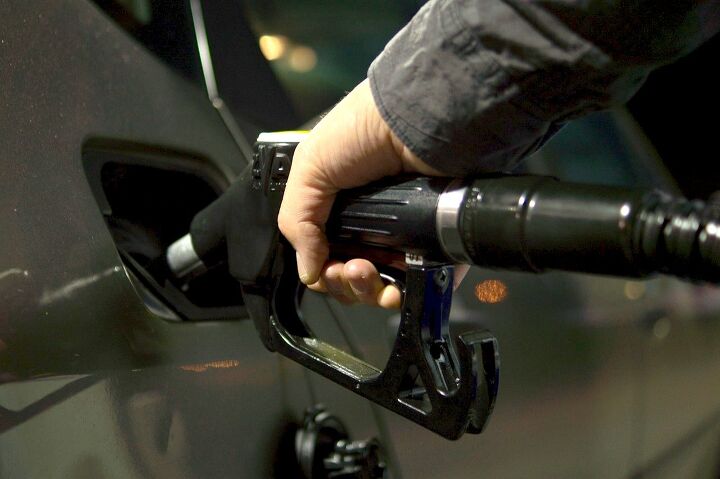The EPA Seems Overly Excited About People Buying SUVs Again

The auto industry’s average fuel economy for new vehicles sputtered upwards by 0.5 miles per gallon last year, according to recent data from the Environmental Protection Agency. While that may sound like cause for celebration, let’s not lose perspective. A statistical record high may be noteworthy, but not necessarily indicative of a new upward trend.
First, let’s try to figure out what happened last year to drive the industry average out of a period of mpg stagnation.
Many vehicles went on a diet last year, shedding weight and improving fuel economy even in cases where the drivetrain remained the same. This was especially true for trucks, which traditionally carry the label of “gas-guzzling pig machines.” Ford’s F-150 lost hundreds of pounds when its body went aluminum.
Weight wasn’t the only factor. Technology did a lot to improve the overall average. Gasoline direct injection appeared on more vehicles, along with turbocharging, more electric hybridization and more efficient transmissions — usually in the form of extra or continuously variable cogs. Mazda, which uses direct injection on all of its engines and has exactly zero hybrid or electric vehicles in its lineup, had one of the highest overall ratings — a 29.6 mpg average.
As great as all of that is, it’s not the whole story. Using data from the University of Michigan’s Transportation Research Institute to track sales-weighted fuel economy ratings from last year, we can see that 2015 was actually pretty flat. Actually, this year has been level, too. In fact, the U of M sales-adjusted data shows a persistent stagnation in fuel economy since 2014.
For the sake of comparison, average new vehicle fuel economy jumped up 2 mpg between 2011 and 2013.
The obvious explanation is that fuel economy is improving, but people aren’t buying the most economical vehicles available. Light trucks, SUVs, and car-based crossovers may be popular, but they won’t match the fuel economy of a small hatchback. General Motors and Toyota found this out the hard way as both had lower fuel economy in 2015 due to increased truck production.
The bad news for the environment is that with gas prices staying so low, there’s less incentive to buy an exceptionally economical car. Still, the EPA numbers show that even the worst fuel offenders have become more efficient.
“Car buyers can go to the showroom knowing that no matter what kind of vehicle they buy, it will be better for the climate — and their wallets — than ever before,” said the EPA’s Director of Transportation and Air Quality Chris Grundler in a release. “This report highlights that the industry is providing vehicles that customers want, while reaching new levels of environmental performance.”
That’s a healthy enough attitude. Though you’d expect the EPA to be a lot less supportive of the automotive industry and the general public gradually turning their backs on more fuel efficient offerings in favor of the “vehicles that customers want.”
[Image: University of Michigan]

A staunch consumer advocate tracking industry trends and regulation. Before joining TTAC, Matt spent a decade working for marketing and research firms based in NYC. Clients included several of the world’s largest automakers, global tire brands, and aftermarket part suppliers. Dissatisfied with the corporate world and resentful of having to wear suits everyday, he pivoted to writing about cars. Since then, that man has become an ardent supporter of the right-to-repair movement, been interviewed on the auto industry by national radio broadcasts, driven more rental cars than anyone ever should, participated in amateur rallying events, and received the requisite minimum training as sanctioned by the SCCA. Handy with a wrench, Matt grew up surrounded by Detroit auto workers and managed to get a pizza delivery job before he was legally eligible. He later found himself driving box trucks through Manhattan, guaranteeing future sympathy for actual truckers. He continues to conduct research pertaining to the automotive sector as an independent contractor and has since moved back to his native Michigan, closer to where the cars are born. A contrarian, Matt claims to prefer understeer — stating that front and all-wheel drive vehicles cater best to his driving style.
More by Matt Posky
Latest Car Reviews
Read moreLatest Product Reviews
Read moreRecent Comments
- Master Baiter The new Model 3 Performance is actually tempting, in spite of the crappy ergonomics. 0-60 in under 3 seconds, which is faster than a C8 Corvette, plus it has a back seat and two trunks. And comparable in weight to a BMW M3.
- SCE to AUX The Commies have landed.
- Arthur Dailey The longest we have ever kept a car was 13 years for a Kia Rondo. Only ever had to perform routine 'wear and tear' maintenance. Brake jobs, tire replacements, fluids replacements (per mfg specs), battery replacement, etc. All in all it was an entirely positive ownership experience. The worst ownership experiences from oldest to newest were Ford, Chrysler and Hyundai.Neutral regarding GM, Honda, Nissan (two good, one not so good) and VW (3 good and 1 terrible). Experiences with other manufacturers were all too short to objectively comment on.
- MaintenanceCosts Two-speed transfer case and lockable differentials are essential for getting over the curb in Beverly Hills to park on the sidewalk.
- MaintenanceCosts I don't think any other OEM is dumb enough to market the system as "Full Self-Driving," and if it's presented as a competitor to SuperCruise or the like it's OK.



































Comments
Join the conversation
Long story short: people are trading-in 25 mpg sedans for 25 mpg crossovers.
Did I read too fast this morning? I don't see anything in the article that supports the headline. No fan AT ALL of many EPA shenanigans, but just asking......